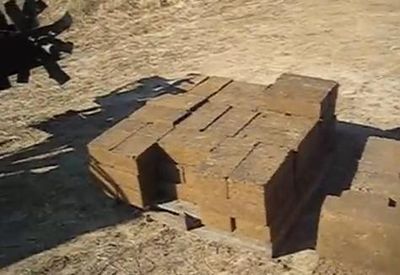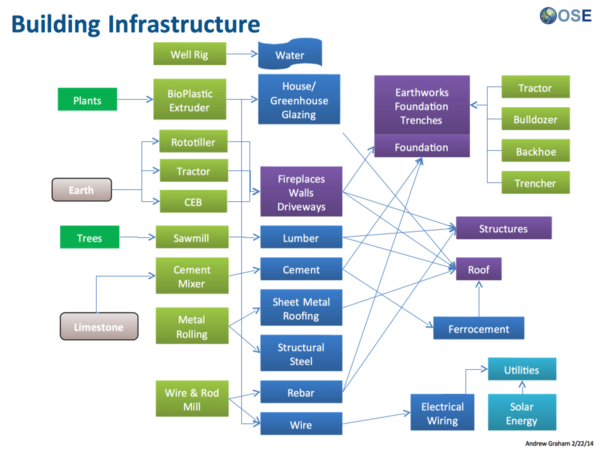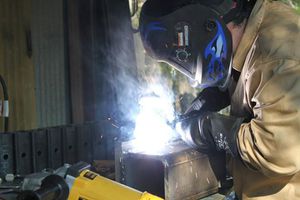CEB Press: Difference between revisions
No edit summary |
No edit summary |
||
| Line 1: | Line 1: | ||
{{OrigLang}} | {{OrigLang}} | ||
<html><iframe src="https://player.vimeo.com/video/49864277" width="500" height="281" frameborder="0" webkitAllowFullScreen mozallowfullscreen allowFullScreen></iframe> <p><a href="http://vimeo.com/49864277">The CEB Story 2012.</a> from <a href="http://vimeo.com/opensourceecology">Open Source Ecology</a> on <a href="http://vimeo.com">Vimeo</a>.</p></html> | <html><iframe src="https://player.vimeo.com/video/49864277" width="500" height="281" frameborder="0" webkitAllowFullScreen mozallowfullscreen allowFullScreen></iframe> <p><a href="http://vimeo.com/49864277">The CEB Story 2012.</a> from <a href="http://vimeo.com/opensourceecology">Open Source Ecology</a> on <a href="http://vimeo.com">Vimeo</a>.</p></html> | ||
=Overview= | =Overview= | ||
[[File:Liberator_bricks.JPG|right|400px|thumb|Bricks pressed on [[The Liberator]]]] | [[File:Liberator_bricks.JPG|right|400px|thumb|Bricks pressed on [[The Liberator]]]] | ||
The Liberator is OSE's automatic, high throughput Compressed Earth Brick Press. It is named The Liberator because it is intended to free people from the single highest cost of living - housing. See [[Cost of Living]] and [[GVCS Naming Convention]]. | The Liberator is OSE's automatic, high throughput Compressed Earth Brick Press. It is named The Liberator because it is intended to free people from the single highest cost of living - housing. See [[Cost of Living]] and [[GVCS Naming Convention]]. | ||
=Versions= | |||
==Version 4== | |||
[[CEB Press IV]] | |||
==Version 3== | |||
[[CEB Press III]] | |||
[[CEB Press 3]] | |||
==Version 2== | |||
[[CEB Press 2]] | |||
==Version 1== | |||
I don't know where about version 1 is. | |||
=Details= | |||
The CEB Press takes earth/dirt/soil and compresses it tightly to make solid blocks useful for building. Compressed earth blocks have many advantages as a building material: by making the building materials from the readily available dirt on the building site, they eliminate the need to transport bricks from elsewhere, reducing financial cost and environmental impact. Compressed earth blocks are very strong and insulate well against both heat and sound, making for very energy-efficient building (especially combined with the energy savings from not needing to transport them from offsite). Best of all, the material they use is already on-site and does not need to be purchased -- quite literally, dirt-cheap! See the wiki page on [[Compressed Earth Blocks]] and the [[:Category:CEB|CEB category]] for more details on building using CEBs. | |||
The Liberator has been fully designed and tested by the [[Open Source Ecology]] team. Because the Liberator is an open source technology, you can freely download instructions to build your own from materials you can obtain yourself, or contact ''opensourceecology[at]gmail[dot]com'' to buy a kit or a finished machine. | The Liberator has been fully designed and tested by the [[Open Source Ecology]] team. Because the Liberator is an open source technology, you can freely download instructions to build your own from materials you can obtain yourself, or contact ''opensourceecology[at]gmail[dot]com'' to buy a kit or a finished machine. | ||
| Line 18: | Line 33: | ||
[[File:Machine.jpg|right|400px|thumb|CEB Press (aka "The Liberator")]] | [[File:Machine.jpg|right|400px|thumb|CEB Press (aka "The Liberator")]] | ||
=Product Ecology= | =Product Ecology= | ||
| Line 47: | Line 58: | ||
*[[Greenhouse]] | *[[Greenhouse]] | ||
*[[HabLab]] | *[[HabLab]] | ||
=See Also= | |||
*[[CEB Design]] | |||
*[[Compressed Earth Blocks]] | |||
*[[Cinva Ram]] | |||
*[[CEB_FAQ]] | |||
*[[CEB Press/Rollers]] | |||
*[[CEB Press/ModularRollers]] | |||
*[[Hablab]] | |||
*[[Metric CEB Press]] | |||
*[[CEB Press/Field Testing 2011|Field Testing 2011]] | |||
*[[CEB Press/Videos]] | |||
----------- | |||
=Assembly= | |||
<html><iframe src="https://player.vimeo.com/video/57424944?color=ffffff" width="500" height="281" frameborder="0" webkitAllowFullScreen mozallowfullscreen allowFullScreen></iframe> <p><a href="http://vimeo.com/57424944">Liberator CEB Press v4 Assembly.</a> from <a href="http://vimeo.com/opensourceecology">Open Source Ecology</a> on <a href="http://vimeo.com">Vimeo</a>.</p></html> | |||
|Components= | |Components= | ||
| Line 69: | Line 102: | ||
* [[CEB 4 design planning]] | * [[CEB 4 design planning]] | ||
* [[CEB Press V]] | * [[CEB Press V]] | ||
{{GVCS Footer}} | {{GVCS Footer}} | ||
Revision as of 02:59, 26 October 2013
The CEB Story 2012. from Open Source Ecology on Vimeo.
Overview

The Liberator is OSE's automatic, high throughput Compressed Earth Brick Press. It is named The Liberator because it is intended to free people from the single highest cost of living - housing. See Cost of Living and GVCS Naming Convention.
Versions
Version 4
Version 3
Version 2
Version 1
I don't know where about version 1 is.
Details
The CEB Press takes earth/dirt/soil and compresses it tightly to make solid blocks useful for building. Compressed earth blocks have many advantages as a building material: by making the building materials from the readily available dirt on the building site, they eliminate the need to transport bricks from elsewhere, reducing financial cost and environmental impact. Compressed earth blocks are very strong and insulate well against both heat and sound, making for very energy-efficient building (especially combined with the energy savings from not needing to transport them from offsite). Best of all, the material they use is already on-site and does not need to be purchased -- quite literally, dirt-cheap! See the wiki page on Compressed Earth Blocks and the CEB category for more details on building using CEBs.
The Liberator has been fully designed and tested by the Open Source Ecology team. Because the Liberator is an open source technology, you can freely download instructions to build your own from materials you can obtain yourself, or contact opensourceecology[at]gmail[dot]com to buy a kit or a finished machine.
Building a machine yourself might seem intimidating, but every step of the process is fully documented and the OSE community is available on our discussion forums if you need help, advice, or a little hand-holding.
Using the CEB Press, two people can build a 6 foot high (1.83m) round wall, 20 feet (6.1m) in diameter, 1 foot (30cm) thick, in one 8 hour day, though construction time will vary somewhat depending on preparation time, what equipment is available (tractor to prepare the ground and move the blocks where they need to go), the quality of the soil, and other factors. The bigger the block size, the faster a wall can be erected, but at the cost of heavier blocks that are more of a strain to work with. Blocks from The Liberator average 25 pounds (11.3kg).
See CEB Design for more information.
Product Ecology

| From | Uses | Creates | Enables |
|---|---|---|---|
|
Components
|
See Also
Assembly
Liberator CEB Press v4 Assembly. from Open Source Ecology on Vimeo. |
Status
- Prototype IV built in a Collaborative Production Run.
- Currently the CEB is at product release status and is being actively manufactured at Factor e Farm and in Texas. The presses will be used heavily as a part of the Factor e Farm Infrastructure Buildout 2011.
- The CEB documentation is being actively upgraded to meet Fabrication_Procedure_Standards with the goal of serving as a reference implementation for GVCS documentation.
- Eventually the torch table will be used to automate the fabrication of the CEB machine, reducing fabrication time by an estimated 20 hours and, thus, the cost to build the machine.
- The first independent replication is in process as of Sep. 2, 2011, by James Slade and Jason Smith in Texas.
- CEB 4 design planning
- CEB Press V








